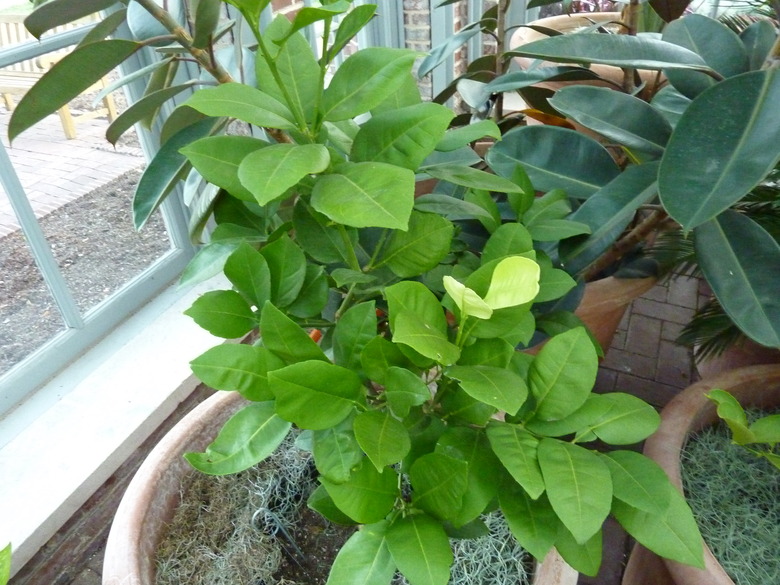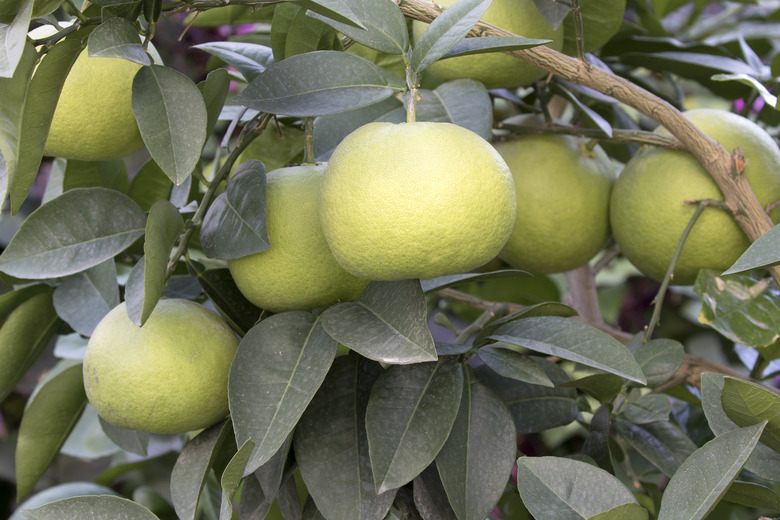Growing Grapefruit Trees Indoors
Many types of citrus fruit trees can be grown indoors, including grapefruit (Citrus x paradisi, USDA zones 9 to 11), which is a hybrid type of citrus tree. In cooler climates, they can be overwintered indoors or kept as a houseplant year round.
Varieties for Grapefruit Trees Indoors
If you want to grow citrus trees indoors, **it is best to purchase grafted dwarf varieties that have maximum heights of approximately 6 feet; a full-sized tree can be up to 30 feet tall.** These varieties set fruit, just like larger trees.
The oroblanco grapefruit (Citrus grandis Osbeck x C. Paradisi Macf., zones 9 to 11) , which produces fruit with white flesh, is a good option for growing indoors.
Tip
The species abbreviation "Macf." used for the oroblanco cultivar denotes a species description by celebrated professor and botanist John M. Macfarlane.
Most dwarf citrus plants are self-fruitful, meaning they do not need to be pollinated by a different variety to produce fruit. However, because citrus trees kept indoors year round may not be exposed to pollinators, you may want to use a paintbrush to transfer pollen from the flower stamens to the pistil to ensure pollination.
Indoor Grapefruit Tree Culture
Let's take a look at the ideal environment for growing grapefruit and other citrus trees indoors.
Growing Medium
Grapefruit trees grow best in potting soil that has a pH between 6 and 7, which is slightly acidic. Cactus potting mix works well for these trees.
Well-draining soil is key, so make sure the container you use has enough drainage holes on the bottom of the pot to prevent soil from becoming soggy.
Light
Indoor citrus trees need sunlight, just like outdoor citrus plants do. If you don't have a sunroom or a solarium in your home, **keep your grapefruit tree near a west or south-facing window where it will receive at least five to six hours of sunlight a day.** You can use grow lights to ensure the tree is receiving enough light.
Temperature
Temperatures between 55 and 85°F are ideal for growing grapefruit trees indoors. Citrus trees like a 10° difference in daytime and nighttime temperatures.
Caring for Indoor Grapefruit Trees
Just like outdoor grapefruit trees, indoor potted plants need water and fertilizer. Let's go over the needs of these trees.
Moisture
Indoor grapefruit trees should be watered once a week. When the top of the soil looks or feels dry to the touch, it is time to water. Deep waterings are better than shallow waterings. Avoid overwatering, however, which causes root rot.
In addition to proper watering, indoor grapefruit trees also need plenty of humidity. Alternatively, you can use a spray bottle filled ideally with rainwater to mist your plant every day. You can also stack your grapefruit tree container on top of a brick placed on a tray of wet pebbles. This helps promote humidity while maintaining good drainage.
Tip
The proper amount of moisture for an indoor citrus tree, including grapefruit, is an important part of indoor care. Avoid overwatering, but try to provide a steady state of humidity.
Fertilizer
During the spring and summer months, fertilize indoor citrus trees every three weeks with a 3-1-1 formula, which means it contains more nitrogen than potassium or phosphorus. In the fall and wintertime, fertilize plants every six weeks.
Pests
Like many indoor plants, grapefruit trees grown inside in containers can attract pests, including spider mites, aphids, whiteflies, mealybugs and scale. Insecticidal soap can be used to keep these pests at bay and control infestations.
Moving Grapefruit Trees Outdoors
When outdoor temperatures reach 50°F in your area, you can move your grapefruit tree outdoors, if you wish. The leaves of a grapefruit tree that is exposed to full sun too quickly may scorch, so acclimate the tree by keeping it in partial shade for one or two weeks before moving it into full sun.
When nighttime temperatures drop below 40°F, it's time to move the tree back indoors.
References
- Iowa State University Extension and Outreach: How do I Care for a Grapefruit Tree?
- Colorado State University Extension: Growing Citrus Indoors
- North Carolina State Extension: Citrus x paradisi
- University of Wisconsin-Madison: Wisconsin Horticulture Division of Extension: Indoor Citrus
- Iowa State University Extension and Outreach: Citrus Trees as Houseplants
- Harvard University: Dr. John M. Macfarlane (1855-1943)

